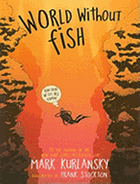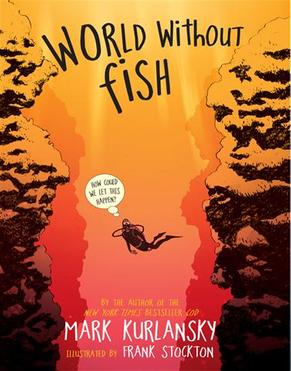
 From the author of Cod,
World Without Fish makes an
impassioned case for readers to look at the mounting evidence of our endangered
marine population and to take steps to save the fish--and our world. Mark
Kurlansky directed this book to children, but the facts presented here will
also be of great interest to adults, especially because the remedies he
suggests are manageable and concrete. By all means, keep eating fish, he
suggests, just be mindful of which varieties are endangered and which are
fished well, and think as well about how you can use less plastic, and walk or bike
more and drive less.
From the author of Cod,
World Without Fish makes an
impassioned case for readers to look at the mounting evidence of our endangered
marine population and to take steps to save the fish--and our world. Mark
Kurlansky directed this book to children, but the facts presented here will
also be of great interest to adults, especially because the remedies he
suggests are manageable and concrete. By all means, keep eating fish, he
suggests, just be mindful of which varieties are endangered and which are
fished well, and think as well about how you can use less plastic, and walk or bike
more and drive less.
Kurlansky begins with Darwin's ideas and applies them in different contexts throughout the book. It's hard to put down because of the way he presents the history of fishing, the impact of the industrial revolution on fishing, the culture that has grown up around fishing, and the author's respect for everyone involved in trying to manage and preserve the fish population. He lets us in on a centuries-old dilemma, and discusses what has worked and what has not worked. Most of all, Kurlansky demonstrates the interconnectedness of all aspects of our environment and how a shift in in the oceans, on land or in the air affects every other area and the species that dwell there. And he repeatedly points to three major factors contributing to the potential unraveling of ocean life: overfishing, pollution and global warming.
Photographs bolster the text and emphasize key elements of his case. In one photo, a Nomura jellyfish, which recently invaded the Sea of Japan in large numbers, dwarfs a scuba diver--it's six feet wide, weighing in at more than 100 pounds. A photo of the orange roughy ushers in what Kurlansky calls this fish's "sad cautionary tale"--a prime example of commercializing a fish that's hauled in from farther out to sea with disastrous results. The endangered orange roughy can live more than 150 years, but doesn't reproduce until it reaches the age of 20; if too many are caught before then, the species could die out. Other photos spotlight key scientists, such as Thomas Henry Huxley, a British scientist and supporter of Darwin's theories, and an influential member of fishing commissions in the 1880s.
Frank Stockton's full-color illustrations dramatize the majesty of the oceans' populations. He moves from full-page portraits of the Atlantic bluefin tuna and of the humpback whale in all their glory to a later image of a polar bear stranded on an ice floe. In addition, the artist provides one-page sequential comics-style artwork that kicks off each of the 11 chapters, charting the changes in the ocean now and imagining the future if current practices continue. These star "Kram and Ailat" (a play on the author's name and that of his daughter, Talia). Kurlansky interrupts a text in predominantly classic serif type with hand-lettered sections in navy, all-capital letters, with key phrases in red, to emphasize his most passionate messages to readers: "Many things, not just fish, are in danger of extinction. Fishermen are in danger of extinction," he writes in connection with Newfoundland, where fishermen no longer reel in cod, and tourism has superseded fishing as the area's main source of income.
Kurlansky delivers a powerful message, neither accusatory nor proselytizing, yet he presents strong evidence that fish and the world as we know it are endangered. Still, he has hope that our ability to make adjustments now can effect lasting change in our environment, and he infects us with hope, too. He suggests steps simple enough for kids to take in their own communities, such as asking the manager in their local grocery store and the waiter in their favorite restaurant where they buy their fish, to ensure they support sustainable fisheries; writing letters to elected officials; and becoming involved in environmental groups. He provides online resources for information about which species are endangered, and evaluates each organization.
This book will be a great gift for nature-loving young people, and could be just as powerful for adults. Beautifully designed, it's well suited to the coffee table as a conversation starter that leads to action.--Jennifer M. Brown

